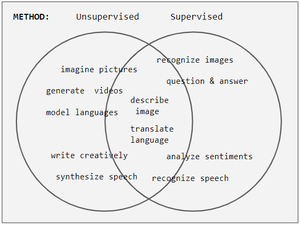
Back تعلم مراقب Arabic گؤزئتیملی (نیظارتلی) اؤیرنمه AZB তত্ত্বাবধানাধীন শিখন Bengali/Bangla Nadzirano učenje BS Aprenentatge supervisat Catalan فێربوونی چاودێریکراو CKB Učení s učitelem Czech Supervised learning Danish Überwachtes Lernen German Επιβλεπόμενη μάθηση Greek
Supervised learning (SL) is a paradigm in machine learning where input objects (for example, a vector of predictor variables) and a desired output value (also known as human-labeled supervisory signal) train a model. The training data is processed, building a function that maps new data on expected output values.[1] An optimal scenario will allow for the algorithm to correctly determine output values for unseen instances. This requires the learning algorithm to generalize from the training data to unseen situations in a "reasonable" way (see inductive bias). This statistical quality of an algorithm is measured through the so-called generalization error.

| Part of a series on |
| Machine learning and data mining |
|---|
- ^ Mehryar Mohri, Afshin Rostamizadeh, Ameet Talwalkar (2012) Foundations of Machine Learning, The MIT Press ISBN 9780262018258.
© MMXXIII Rich X Search. We shall prevail. All rights reserved. Rich X Search